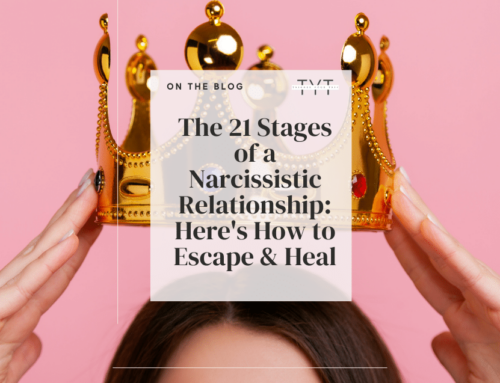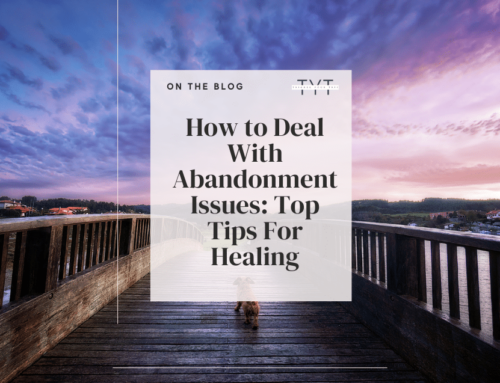Do you ever want to connect and form a relationship with someone but instinctively push them away when any hint of emotional closeness develops? Can you recall that ex of yours who, although they seemed to like you and enjoy your company, got cold feet whenever you expressed your feelings or lavished them with attention? People with a dismissive avoidant attachment style have difficulty seeing an “I love you” text on their screens, but they don’t understand how that behavior sabotages their relationships.
So, instead of thinking that there’s something seriously wrong with you, understanding the causes of dismissive avoidant attachment may help.
This attachment style is characterized by fear of intimacy and other emotions like loneliness and confusion, and these individuals avoid emotional connection at any cost. We must learn how to manage these feelings effectively, whether we are insecurely attached or connected to someone who is, to build emotionally and physically fulfilling relationships with partners, friends, and family members.
What better way than finding out why it exists in the first place?
What Is Attachment Theory?
Attachment theory explains the dynamics of long-term relationships between humans, emphasizing how our early connection patterns with our primary caregivers shape how we interact with others later in our relationships.
Attachment theory suggests that our earliest social interactions are crucial to forming healthy bonds later in life.
This theory proposes that infants come into the world pre-programmed to form attachments with their primary caregivers. As they grow, these attachments become a template for all future relationships.
How this attachment style develops depends on the quality of care an infant receives from its primary caregiver.
Not only does one’s attachment style have implications for social and personal relationships in adulthood, but it has also been linked to academic performance, emotional intelligence, and overall mental health throughout life.
Overall, attachment theory helps us understand why specific interpersonal patterns emerge in our lives due to our early childhood experiences and emotional intimacy with primary caregivers. It’s essential to get the help of a mental health professional who can help us learn how to look into them to understand better the process of meeting our own emotional needs and having healthier relationships.
Do you have difficulty choosing a mental health professional? Can’t afford in-person couples or individual therapy?
This online therapy toolbox is more efficient and affordable than any other virtual therapy I’ve tried, including BetterHelp and Talkspace. It instantly matches you with a therapist and saves you hours of research for the right one (with unlimited daily messaging and support from your therapist). By leveraging the power of CBT (Cognitive Behavioral Therapy) -the most common psychotherapeutic approach for treating mental health problems- your therapist will guide you to a happier self through weekly sections, CBT worksheets, unlimited messaging, and daily worksheet replies. Bonus price for the fact that you can do your sessions wherever you are in the world and message your therapist anytime, daily.
The Different Attachment Styles
The main attachment styles include secure, anxious, fearful, avoidant, and dismissive, each of which has implications for one’s early adulthood, close relationships, emotional vulnerability, and communication skills.
Anxious preoccupied attachment style
An anxious attachment style is characterized by an extreme need for closeness, attention, and approval from others and an intense fear of abandonment.
People with this attachment style tend to suffer from emotional permanence, be overly clingy and dependent, require social support, and often feel abandoned or rejected even when their partner is emotionally available.
This can lead to unhealthy patterns of behavior and communication, such as excessive worrying or clinging, as well as difficulty trusting others.
Anxiously attached individuals are also more likely to experience depression, anxiety, and low self-esteem in adult relationships.
Related: Emotional Permanence Explained & 5 Top Tips on How to Cope
Dismissive avoidant attachment style
Dismissive Avoidant attachment is characterized by an individual’s fear of commitment and difficulty connecting with others emotionally. People who exhibit this attachment style tend to be independent and self-reliant.
They may also struggle to open up in relationships, preferring to ignore or minimize their emotions. This can lead to a lack of closeness in a relationship and difficulty in forming intimate relationships.
In addition, dismissive avoidants may also have trouble expressing themselves and understanding the emotions of others, which can be challenging when trying to develop lasting romantic relationships or create attachment security.
Fearful avoidant attachment style
Fearful Avoidant is an attachment style based on an individual’s intensified fear of rejection, alongside a strong desire for connection and intimacy. People with a fearful attachment type often have difficulty expressing their needs and may be reluctant to form relationships due to fear of being hurt.
They also tend to be overly sensitive to criticism or rejection and may struggle to rely on their partners. While fearful avoidants have difficulty connecting with others emotionally, they can eventually learn to foster emotional intimacy in relationships by learning to recognize and express their feelings in a safe environment and positive light.
Related: Fearful Avoidant Attachment: 7 Signs of Craving Yet Fearing Love
Secure attachment style
Secure attachment is characterized by an individual’s ability to form safe and trusting relationships with others. They can trust and rely on their partners in romantic relationships, communicate their needs, as well as empathize with the feelings of those around them. Individuals also have a better sense of self-confidence and high self-esteem, which can help them navigate complex social dynamics.
Securely attached individuals are better equipped to handle the complexities of adult relationships due to their increased capacity for empathy towards others and their ability to rely on others.
This can lead to more meaningful connections because they don’t avoid emotional bonds and can better understand each other’s needs.
A secure attachment style can also help reduce stress levels because the relationships are comforting, allowing people to feel emotionally supported without fear of emotional distance. Securely attached individuals are also more resilient in adversity because they have developed the skills necessary for forming healthy relationships.
So, What Exactly Is a Dismissive Avoidant Attachment Style?
As mentioned earlier, dismissive-avoidant attachment is characterized by an individual’s fear of intimacy and commitment. People who exhibit this attachment style tend to be independent, often trying to ignore or suppress their emotions instead of expressing them. This can lead to a lack of closeness, difficulty in healthy relationships, and struggles with communication, especially with partners who excessively worry or cling.
A dismissive avoidant attachment style results in a higher risk for depression, anxiety, and greater relationship insecurity due to avoiding emotional bonds. Individuals may also struggle to trust or rely on their partners, which adds tension and distance.
Additionally, difficulties understanding one’s emotions and those around them can be challenging for individuals with a dismissive avoidant attachment style when creating secure attachments.
As a result, these individuals may either avoid committed relationships or find themselves trapped in cycles of unfulfilling bonds that start strong but eventually end due to difficulties in managing conflict or expressing intimate emotions. These problems stem from the restrictive environment set up by the individual’s own feelings and dismissive tendencies towards intimacy.
Related: How Hyper-Independence Can Signify Trauma (& 5 Ways To Cope)
What Causes a Dismissive Avoidant Attachment Style?
Parental Neglect
Parental neglect can be a significant cause of dismissive avoidant attachment. Neglectful parenting is characterized by little to no emotional support, physical care, and guidance in the child development phase. This may lead to the individual feeling unloved and unappreciated, leading to one of the insecure attachment styles and causing them to suppress seeking support and attention.
Unmet needs
Unmet needs can also contribute to the development of dismissive avoidant attachments. When individuals cannot meet their needs in childhood, either through a lack of parental awareness or too much parental control, they may struggle to form secure attachments in adulthood. This is because individuals who have not had their needs for affection and validation met in childhood make it a defense mechanism not to trust others -whether family, friends, or romantic partners.
Hurtful and dismissive experiences
Hurtful and dismissive experiences, such as verbal or physically abusive behavior, can also contribute to the development of dismissive avoidant behavior during adult attachment. When a child is subject to negative and hurtful experiences at an early age, it can damage their mental health and ability to form secure attachments with adults, as adults.
Related: The 7 Stages of Trauma Bonding; Here’s Why You Can’t Leave
What Are Signs of Dismissive Avoidant Attachment?
Brief and casual relationships
One of the common signs of dismissive avoidant attachment is having brief and casual relationships. Dismissive avoidants often struggle to form close, meaningful connections in a romantic relationship because of their unconscious and childhood fear of getting hurt or feeling vulnerable. As a result, their relationships tend to be kept at a distance which can lead to them being involved in short-term and superficial relationships. They may also find it challenging to commit long-term due to fear of abandonment or rejection, resulting in avoiding intimate conversations and activities such as discussing past experiences, feelings or plans.
Fear of intimacy
Fear of intimacy is a common symptom of this attachment pattern. It occurs when individuals become overwhelmed by closeness, vulnerability, and connection in personal relationships. A dismissive-avoidant person often has difficulty expressing emotions, trusting others, and being open and comfortable in intimate relationships. This fear of intimacy is often rooted in past relationships that lack depth or warmth.
Detaching from partner
Detaching from one’s partner is a tell-tale sign of the avoidant dismissive attachment style. Dismissive-avoidant people often struggle to connect deeply emotionally due to their fears and vulnerabilities seeping into their adult attachment styles, leading to them avoiding intimate conversations, activities, and physical contact. As a result, they may not only find it difficult to get close to their partner and may even withdraw from them altogether, resulting in feelings of disconnection or distance.
Inability to express feelings and emotions
One of the signs of the avoidant dismissive attachment style is an inability to express one’s feelings and emotions effectively. This often stems from not developing healthy emotional skills during childhood due to a lack of validation or support from parents or caregivers. Those dismissive avoidant attachments may also be fearful or vulnerable when expressing emotions such as love or compassion – which would not have been an issue had they had a more secure attachment style.
High, unrealistic standards of an “ideal partner”
Finally, people with a dismissive avoidant attachment may have an unrealistic view of a perfect partner. This often leads them to set unrealistic standards for their partners, which can be overwhelming and exhausting for their significant other. Because they struggle to form close connections in relationships, a dismissive avoidant will try to convince themselves that no one meets these standards and will give up on the relationship quickly.
An extreme need for autonomy and independence
A dismissive-avoidant person may also have an extreme need for autonomy and independence. This often means they are unwilling to compromise or depend on their partner for emotional or physical support, leading them to remain distant and emotionally unavailable. This can cause feelings of loneliness and disconnection and is one of the reasons how dismissive avoidant attachment can cause the relationship’s demise.
Secretive and unable to build trust or handle conflict
Lastly, dismissive avoidant attachment can make it difficult for individuals to build trust and handle conflict. This is because they cannot emotionally connect with their partner and often resort to secrecy or avoidance when faced with disagreements. This can lead to frustration in the relationship, as their partner may find it difficult to communicate without getting hurt or feeling unheard.
Related: Reactive Abuse & Narcissism: What Is It & How To Deal With It
Can A Dismissive Avoidant Fall in Love?
Yes, a person with an avoidant attachment style can fall in love. Despite their difficulties in forming close connections and being emotionally available, they can overcome these obstacles and build meaningful relationships.
The practical advice here is for the individual to be willing to work on developing their emotional skills, such as healthily communicating their feelings and needs. They also need to learn to trust and be vulnerable with others, which can help them form deeper connections necessary for falling in love. Additionally, they need to know that their expectations of an ideal partner are realistic and achievable without sacrificing either person.
It may take time for avoidant adults to open up and be comfortable enough in a relationship to fall in love.
However, when they do eventually reach this point, they can find themselves experiencing newfound joy and appreciation that comes from being fully connected with another human being while having a healthy relationship. It requires both partners’ patience, understanding, time, and willingness to flourish in this connection.
Related: 8 Incredible Ways Spiritual Counseling Can Transform your Life
Dismissive Avoidant Attachment Style Treatment: Is It Curable?
The good news is that an insecure attachment style is curable. Here’s what you can do:
Nurture the emotional connection.
Nurturing the emotional connection you might build with others is vital to curing avoidant attachment. This involves allowing yourself to feel you’re in a safe, secure, and non-judgmental space that allows you to express your feelings and needs -which is often the job of your relationship coach or therapist. It also involves learning to communicate effectively and openly to build relationships based on mutual trust and understanding.
Practice writing down your feelings and needs.
Writing down your feelings and needs is another way to help yourself or encourage an individual with the avoidant attachment style to express emotions. Writing can be a helpful tool for letting feelings come out, especially those too difficult to vocalize, and identifying a relationship’s wants and needs to understand better how to build healthier dynamics.
A conscious effort to spot your patterns of running away
Finally, if you’re a dismissive avoidant, you should consciously try to spot your relationship patterns of running away from people who want to get close. This will help you recognize and work through the underlying issues preventing you from forming strong bonds with others. Through self-reflection, you can gain insight into your behavior and take steps toward understanding whether you’re running away.
Seek support from a therapist.
For those struggling with dismissive avoidant attachment, it can be beneficial to speak with a therapist. A professional can provide you with the tools needed to manage your emotions and build healthy connections in relationships. A therapist can also guide and support you throughout learning to become emotionally available while maintaining personal boundaries in a safe, non-judgmental space.
Related: 9 Mommy Issues in Men That Make Him Avoid Commitment
Final thoughts
Ultimately, dismissive avoidant attachment can be challenging to confront and treat. It is important to remember that everyone has a unique journey to healing and building healthy relationships. It will take patience, dedication, and willingness to understand the needs of yourself and your partner to form a strong bond of trust and mutual respect.
Despite the difficulties involved in developing close connections and being emotionally available, with proper support, you can learn how to manage your emotions better and create meaningful connections with those around you.
Read more: 5 Books on Attachment Theory Explain Your Obsession Over Certain People





